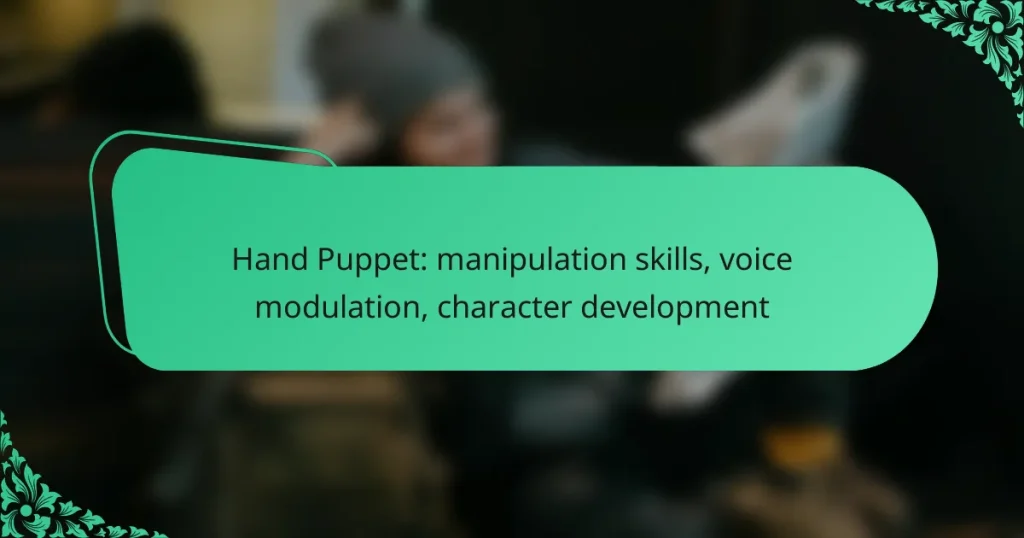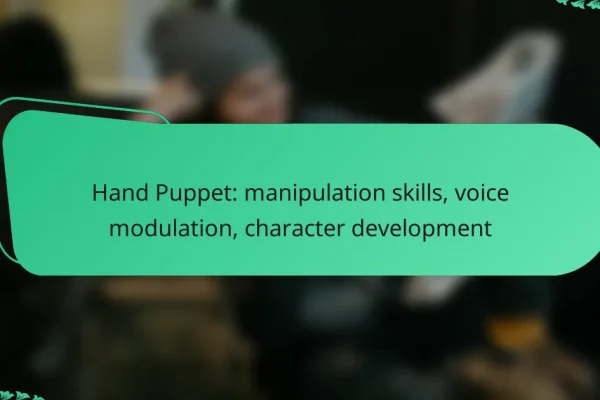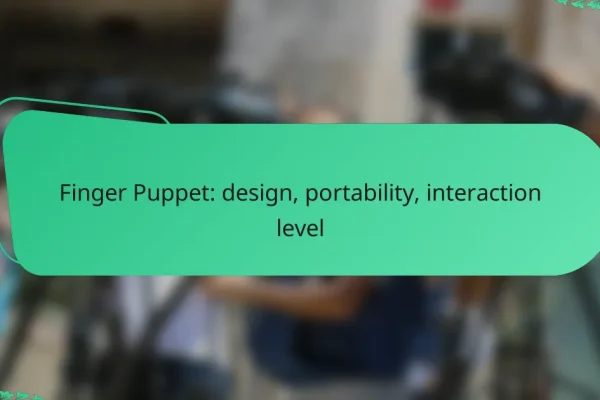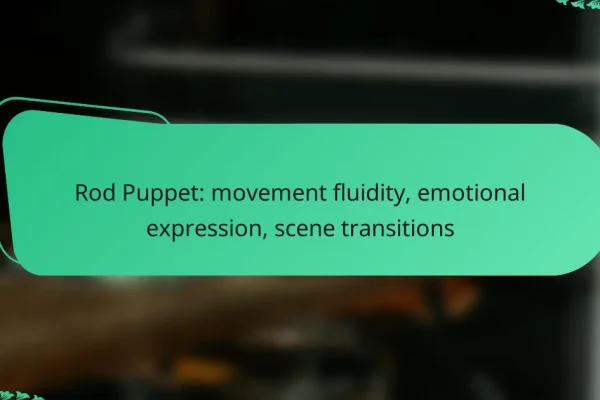
Hand Puppet: manipulation skills, voice modulation, character development
Hand puppetry is a dynamic art form that combines manipulation skills, voice modulation, and character…
Puppetry is a captivating art form that combines creativity and performance to engage audiences of all ages. This comprehensive guide explores the various types of puppets suitable for performances in Australia, including marionettes, hand puppets, and ventriloquist dummies, each offering unique advantages. Understanding your audience and performance space is essential for selecting the right puppet, ensuring a memorable experience for all. Discover where to find high-quality puppets and what to consider when making your purchase.

Hand puppetry is a dynamic art form that combines manipulation skills, voice modulation, and character development to create engaging performances. By honing finger dexterity and mastering professional techniques, puppeteers can enhance their control and creativity. Additionally, effective voice modulation helps bring distinct characters to life, while developing rich personalities ensures a deeper connection with the…

Finger puppets are a delightful blend of creativity and portability, featuring vibrant designs that captivate the imagination. Their compact size allows for easy transport, making them perfect companions for travel or on-the-go play. With a focus on interaction, these puppets encourage storytelling and imaginative engagement, making them valuable tools for both entertainment and education. What…

Collectible puppets, such as antique marionettes and handcrafted ventriloquist dummies, are prized for their rarity and exquisite craftsmanship. These unique pieces not only serve as captivating art forms but also hold significant investment potential, making them appealing to collectors. Understanding the factors that influence their value, including production numbers and the reputation of the maker,…

Maintaining an interactive puppet requires attention to technology upkeep, including battery care and software updates. Regular cleaning, proper storage, and scheduled maintenance checks are essential for optimal performance and longevity. Additionally, using the correct battery types and following charging guidelines will help ensure your puppet remains efficient. Don’t forget to regularly update the software through…

Finger puppets serve as a powerful tool for improvisation and interaction, offering a simple yet effective means of creative expression. They encourage spontaneous performances, especially among children, fostering imagination and enhancing communication. With their hands-on approach, finger puppets streamline storytelling, allowing for a focus on narrative and character development without the distraction of complex props….

Theater puppets are a captivating blend of durability, stage presence, and versatility, making them essential tools for engaging performances. Crafted from high-quality materials, these puppets are designed to withstand frequent use while delivering powerful emotional connections to the audience. With various types available, such as shadow and rod puppets, each offers unique characteristics that enhance…

Rod puppetry is an art form that thrives on the fluidity of movement and the depth of emotional expression. By utilizing quality materials and advanced joint mechanisms, puppeteers can create graceful and engaging performances. Thoughtful design and intentional body language further enhance the emotional connection, while seamless scene transitions ensure a cohesive storytelling experience. How…

Marionettes are intricate puppets that rely on precise control mechanisms, such as string systems and levers, to create captivating performances. The length of the strings plays a crucial role in determining the marionette’s range of motion and control, while the weight of the puppet influences its stability and ease of manipulation. Understanding these factors is…

Preparing for a Puppet Festival performance in Australia requires meticulous planning and creativity, from selecting the ideal venue to coordinating rehearsals and finalizing costumes and props. These festivals not only showcase artistic talent but also provide valuable networking opportunities, allowing participants to connect with industry peers and explore potential collaborations. Engaging the audience is essential,…

Cultural puppets are vital artifacts that embody the traditions and stories of various communities, serving as a bridge to the past. Preserving these puppets requires careful attention to environmental conditions and specific care techniques tailored to their materials, ensuring their integrity for future generations. Proper display practices not only enhance their visual appeal but also…
The best types of puppets for performances in Australia include marionettes, hand puppets, shadow puppets, rod puppets, and ventriloquist dummies. Each type offers unique characteristics and advantages that cater to different performance styles and audience engagement.
Marionettes are puppets controlled by strings, allowing for intricate movements and expressions. They are often used in theatrical performances due to their ability to convey complex emotions and actions.
When using marionettes, consider the skill level required for manipulation, as they can be challenging to master. They are best suited for performances in larger venues where their detailed movements can be appreciated.
Hand puppets are simple to operate, with the puppeteer controlling them directly with their hand. This type is popular for children's shows and informal performances due to their ease of use and immediate audience connection.
For effective hand puppet performances, focus on character development and voice modulation. They work well in smaller settings, such as schools or community events, where interaction is key.
Shadow puppets are flat figures that are cast onto a screen using a light source, creating engaging visual stories. This type of puppet is often used in storytelling and educational performances, making it a versatile choice.
To create captivating shadow puppet shows, use contrasting materials and ensure proper lighting. They are ideal for both indoor and outdoor performances, especially during festivals or cultural events.
Rod puppets are controlled by rods attached to their limbs, allowing for dynamic movements while being easier to handle than marionettes. They are often used in both children’s theatre and adult performances.
When selecting rod puppets, consider their size and weight for ease of manipulation. They can be effective in various performance settings, from schools to professional theatres, due to their versatility.
Ventriloquist dummies are designed for ventriloquism, where the performer speaks without moving their lips, creating the illusion that the dummy is speaking. This type of puppet is popular in comedy acts and entertainment shows.
For successful ventriloquism, practice is essential to master voice control and timing. These dummies are suitable for a range of venues, from comedy clubs to corporate events, where humor and interaction are valued.
Choosing the right puppet for your show involves understanding your audience, the performance space, and your budget. Each of these factors plays a crucial role in ensuring that the puppet enhances the overall experience and meets the needs of your production.
When selecting a puppet, consider the age of your audience. Different age groups respond to various styles and types of puppets. For instance, younger children often enjoy colorful, cartoonish puppets, while older children and adults may appreciate more sophisticated designs or themes.
Think about the content of your show as well. If your performance includes complex themes, choose puppets that can convey emotions effectively to engage older viewers. Conversely, for a younger audience, opt for playful and simple characters that can hold their attention.
The performance space significantly influences your puppet choice. Consider the size and layout of the venue. Larger spaces may require bigger puppets or those that can be seen from a distance, while smaller venues allow for more intimate puppetry styles.
Additionally, assess the technical aspects of the space, such as lighting and sound. Some puppets may require specific lighting to enhance their features, while others might need sound effects to create a more immersive experience. Ensure that your puppet choice aligns with the capabilities of your performance area.
Your budget is a critical factor in choosing the right puppet. High-quality puppets can range from affordable to quite expensive, depending on materials and craftsmanship. Set a clear budget before you start shopping to narrow down your options effectively.
Consider the long-term use of the puppet as well. Investing in a durable puppet may save money in the long run, especially if you plan to perform multiple shows. Look for puppets that offer a good balance between quality and cost, and don’t forget to factor in additional expenses like maintenance or accessories.
In Australia, high-quality puppets can be found at specialized stores, online platforms, and dedicated puppet shops. When purchasing, consider factors like material, craftsmanship, and the intended use, whether for performance, education, or play.
Puppet Paradise is a well-known retailer in Australia that offers a wide range of puppets, from hand puppets to marionettes. They focus on quality craftsmanship and often feature unique designs that appeal to both children and adults.
Shopping at Puppet Paradise allows you to explore various puppet styles, including educational puppets and themed characters. Their knowledgeable staff can assist in selecting the right puppet for your needs.
The Puppet Store specializes in high-quality puppets and puppet-making supplies. They offer a diverse selection, catering to both hobbyists and educators looking for engaging teaching tools.
In addition to puppets, The Puppet Store provides resources for puppet-making, including patterns and materials. This makes it an excellent choice for those interested in creating their own puppets.
Online marketplaces like eBay and Etsy feature numerous sellers offering high-quality puppets from various artisans. These platforms allow you to compare prices and styles easily, often providing unique, handmade options.
When buying from online marketplaces, check seller ratings and reviews to ensure quality. Be mindful of shipping costs and delivery times, especially if you need the puppet for a specific event or performance.
The key techniques for puppeteering include manipulation, voice modulation, and character development. Mastering these techniques allows puppeteers to create engaging performances that captivate audiences.
Manipulation techniques involve the physical control of the puppet to convey emotion and action. Common methods include using rods, strings, or hand movements to animate the puppet effectively. For example, a marionette requires precise string control, while hand puppets rely on direct hand movements.
Practicing basic movements like walking, waving, or nodding can help puppeteers develop their skills. It's essential to maintain smooth and fluid motions to enhance the puppet's believability. Avoid jerky movements, as they can break the illusion of life.
Voice modulation is crucial for bringing a puppet's character to life through vocal expression. Puppeteers should vary pitch, tone, and speed to match the puppet's personality and emotions. For instance, a cheerful character might have a higher pitch and faster speech, while a grumpy character could use a lower tone and slower delivery.
Practicing vocal exercises can improve a puppeteer's ability to create distinct voices. Recording and listening to performances can help identify areas for improvement. Avoid monotone delivery, as it can make the character feel flat and uninteresting.
Character development involves creating a backstory and personality for the puppet, which enhances audience connection. Consider traits such as age, interests, and quirks that make the character relatable. A well-developed character can evoke empathy and engagement from the audience.
To develop a character, start by writing a brief profile that includes key attributes and motivations. Experiment with different personalities to see what resonates best with your audience. Avoid clichés, as they can make characters feel predictable and less engaging.
Creating your own puppets involves selecting materials, designing your puppet, and following a crafting process. This hands-on activity allows for creativity and personalization, making it suitable for both children and adults.
To craft puppets, you will need basic materials such as fabric, foam, or paper for the puppet body. Additional supplies include scissors, glue, markers, and any embellishments like buttons or yarn for details. Consider using recycled materials to make the project more eco-friendly.
For puppets that require movement, such as marionettes, you may need strings, wooden dowels, or even a simple mechanism. Ensure that all materials are safe and suitable for the intended age group of the puppeteer.
Begin by sketching your puppet design on paper, deciding on its features and colors. Cut out the puppet body from your chosen material, ensuring to leave extra for seams if necessary. Assemble the pieces using glue or stitching, depending on the material.
Next, add details such as eyes, mouth, and hair using your embellishments. If creating a puppet that requires movement, attach strings or rods at this stage. Finally, test your puppet to ensure it moves as intended and make any adjustments needed for better performance.